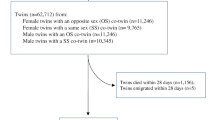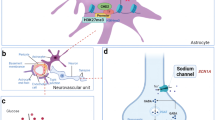Abstract
The study explores the possibility of a higher risk of epilepsy in twins than in singletons. The concordance for epilepsy in MZ twins (66·7%) was higher than in DZ twins (12·5%), thus supporting the hypothesis of genetic predisposition. The incidence of epilepsy in twins is 46·7 per 1000 cotwins while in general population it varies from 3·6 to 10·38 per 1000. This shows that twins have appreciably higher risk of epilepsy than singletons. The present study suggests an association of the twinning phenomenon with a higher risk of epilepsy.
Similar content being viewed by others
References
Jennings MT. Genetic influences in the epilepsies. Review of literature with practical implications.Am J Dis Child 1981;135: 450–457
Fukuyama Y, Kagawa K, Tanaka K. A genetic study of febrile convulsions.Eur Neurol 1979;18: 166–182
Lerman P, Apter N. Familiality of benign focal epilepsy of childhood.Herefuah 1981;100: 160–161
Guthrie RH, Lebowitz WM. Epilepsy in identical twins.J Nerv Ment Dis 1935;81: 388–398
Lennox WG, Gibbs EL, Gibbs FA. Twins, brain waves and epilepsy.Arch Neurol Psychiat 1942;47: 702–706
Lennox WG. The heredity of epilepsy as told by relatives and twins.JAMA 1951;146: 529–536
Dharampal N, Ramamurthi B. Epilepsy in twins.Inst Neurol Madras Proc 1973;3: 231–242
Shukla R, Nag D, Misra UK, Malik GK. A typical petitmal epilepsy in twins.Indian J Pediatr 1981;48: 179–181
Lennox WG, Gibbs EL, Gibbs FA. The inheritance of epilepsy as revealed by the electro-encephalograph.Neurol Psychiat 1940;44: 1155
Noebels JE and Sidman RL. Inherited epilepsy: Spikewave and focal motor seizures in the mutant mouse tottering.Science 1979;204: 1334–1336
Dailey JW, Jobe PC. Effect of adrenalectomy on sound-induced seizure susceptibility and intensity in genetically susceptible rats.Experientia 1981;37: 737–738
Doose H. Genetic aspects of epilepsiesFolia Psychiat Neurol 1981;35: 231–242
Newmark ME, Penry JK.Genetics of epilepsy: a review. New York: Raven Press, 1980, p 122
Dumermuth G. Genetic factors in epilepsy.Schweiz Rundsch Med Prax 70 1981;36: 1531–1539
Propping P, Vogel F. Twin studies in medical genetics.Acta Genet Med Gemellol 1976;25: 249–258
Stevenson AC, Johnston HA, Golding DR, Stewart MJP. World Health Organization, comparative study of congenital malformations.Bull WHO 1966;34: (Suppl)
Edwards JH. The value of twins in genetic studies.Proc Roy Soc Med 1968;61: 227–229
Hay S, Wehrung DA. Congenital malformations in twins.Amer J Hum Genet 1974;22: 662–678
Sharma K. Susceptibility to motion sickness.Acta Genet Med Gemellol 1980;29: 157–162
Sharma K. Seasonal variation in twinning in India.Man in India 1980;60: 254–260
Sharma K. A demographic study of Indian twins.Indian J Phys Anthrop Hum Genet 1980;6: 137–142
Sharma K. Parental age, parity and sibship size of North Indian twins.Anthropos 1981;76: 237–239
Sharma K, Byard PJ, Russel JM and Rao DC. A family study of anthropometric traits of a Punjabi community: I. Introduction and familial correlations.Am J Phys Anthrop 1984;63: 389–395
Sharma K, Byard PJ and Rao DC. A commingling in the distributions of fat related measures in Punjabi families.Human Heredity, 1984;34: 278–184
Sharma K and Sharma JC. Familial resemblance for head size in a Punjabi population of India.Annals of Hum Biology 1984;11: 577–580
Byard PJ, Sharma K, Russeli JM and Rao DC. A family study of anthropometric traits in a Punjabi community: II. An investigation of familial transmission.Amer J Phys Anthrop 1984;64: 97–104
Gibbs FA, Gibbs EL and Lennox WG. Epilepsy: a paroxysmal cerebral dyrrhythmia.Brain 1937;60: 307
Sethi BB, Gupta SC, Mahendru RK and Kumari P. Mental health and urban life—a study of 850 families.Brit J Psychiat 1974;124: 243–246
Mathai KV, Somasundram PC, Rao PSS and Korula P. Final report of investigation into methods for the rehabilitation of persons disabled by convulsive disorder. SRS Report No. 19 p 58113 F-01. Christian Medical College and Hospital, Vellore 1971
Nandi DN, Ajmany S, Ganguli Het al. Psychiatric disorders in a rural community in West Bengal. An epidemiological study.Indian J Psychiat 1976;17: 87–99
Aicardi J (Technical committee of the French league against epilepsy). General conclusions concerning familial factors in epilepsy.Epilepsia 1969;10: 65
Metrakos JD and Metrakos K. Genetic studies in clinical epilepsy. In:Basic mechanisms of epilepsies. HH Jasper, AA Ward, A Pope, eds. London: J & A Churchill Ltd.
Frantzen E, Lennox-Buchthal M, Nygaard A and Stene J. A genetic study of febrile convulsions.Neurology (Minneapolis) 1970;20: 909
Ounsted C. Some aspects of seizure disorders. In:Recent advances in pediatrics. D Gairdner and D Hull, eds. London: Heinemann, 1971. 3 p
Malzberg B. The incidence and prevalence of intramural epilepsy. In:Epilepsy psychiatric aspects of convulsive disorders PH Joch and RP Knight, eds. New York: Hafner; p 43
Reid.People with epilepsy. Report of central health services council. London: HMSO.
Myrianthopoulos NC. Congenital malformations: The contribution of twin studies.Birth Defects 1978;14: 151–165
Windham GC, Sever LE. Neural tube defects among twin births.Amer J Hum Genet 1982;34: 988–998
Hay S and Wehrung DA. Congential malformations in twins.Amer J Hum Genet 1970;22: 662–678
Lady PM, Erickson JD, Falek A, McCarthy BJ. Congenital malformations in twins.Amer J Hum Genet 1980;32: 69–78
Windham GC and Bjerkedal T. Malformations in twins and their siblings, Norway, 1967–79. Twin Research 4—Part A: Biology and obstetrics.Acta Genet Med Gemellol 1984;33: 87–95
Author information
Authors and Affiliations
Rights and permissions
About this article
Cite this article
Sharma, K. Higher risk of epilepsy in twins. Indian J Pediatr 53, 515–519 (1986). https://doi.org/10.1007/BF02749538
Published:
Issue Date:
DOI: https://doi.org/10.1007/BF02749538




